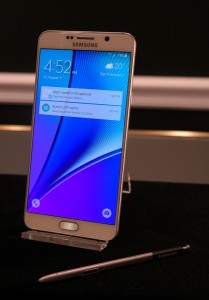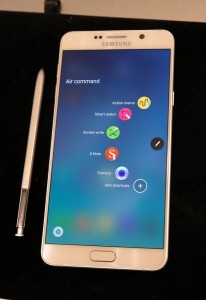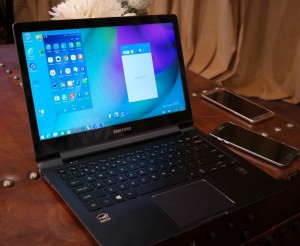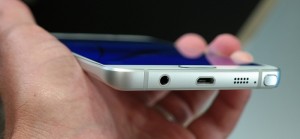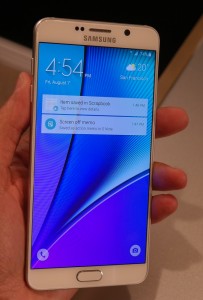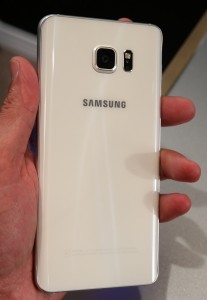Samsung’s Android tweaks have always been a double-edged sword. While it’s hard to deny the utility of TouchWiz additions like Multi Mode, which provided true multitasking on Android, Samsung’s heavy-handed approach too often left devices feeling bloated at best, and sluggish at worst.
Maybe because Google eventually coopted some formerly TouchWiz-specific features like resizable widgets, and too many were unnecessary (Smart Scroll, perhaps?), many critics (this one included) pined for a more pure Android experience on Samsung’s impressive hardware.
This duality was especially salient on the Galaxy Note series. On one hand, the S Pen active stylus proved incredibly useful for navigating Android on the large screen, and the Galaxy Note was the definitive Android productivity device. But most of the stylus-specific features seemed tacked on, awkwardly accessed, and divorced from typical Android workflows.
So this is where things stand going into the fifth-generation of Galaxy Note smartphones. And good news, Samsung seems to have addressed it.
(Update 8/21/15: The Samsung Galaxy Note5 review is live.)
Pen UX
Samsung claims that its Galaxy Note5 is “engineered to help people get more done, faster.” To that end, the Air Command shortcuts that call up the Pen-specific features are readily available via an ever-present icon that hovers on the large, 5.7-inch display. There is more than enough screen real estate that it doesn’t seem to get in the way during our time testing it, and activated, the display blurs, leaving only the shortcuts in focus.
All the familiar Note tools are there: Action memo, Smart select, Screen write, and S Note, as well as a camera shortcut, and room for additional user-selected shortcuts. All are labeled, and there are no opaque icons (figuratively speaking) there to confuse users.
Just the mere additions of an icon shortcut, the display blur, and labeled icons, makes the entire Pen user experience seem more organic and ingrained in the device.
Samsung also added three new features that power users should love. Whereas previous Notes simply wrote over PDFs, Note5 users can now actually annotate them. A Scroll Capture feature snags screenshots that extend beyond the display for one continuous jpeg, which is perfect for directions and reading long articles offline (and perfect for Google to steal for future Android versions). And finally, popping out the Pen no longer turns on the device. Instead, it activates the display, but keeps it black, turning it into an impromptu scratchpad. Anything jotted down, an address, phone number, or quick note, is then saved in S Note.
Galaxy Features
The Samsung Galaxy Note5 will launch alongside theSamsung Galaxy S6 edge+, and both will share additional software tweaks. Both will have a fingerprint sensor andKNOX security, so the Android smartphones will support Samsung Pay, which works with both NFC and MST (Magnetic Secure Transmission). For users, that means Samsung Pay will work with just about any credit card reader, whether they support wireless transactions or not. This killer feature should not go unnoticed. Samsung Pay has the potential to be accepted everywhere that accepts credit and debit cards – even small mom and pop shops.
Both devices will also have broadcast support built into the camera app for streaming live to YouTube Live, both audio and video. Both have an audio upscaling feature that Samsung claims brings streaming audio up to CD-like quality, as well as a similar Bluetooth upscaling for streaming to specific Samsung headphones and speakers. And both will feature SideSync 4.0 for sending and receiving files wirelessly to a PC or Mac.
What’s cool about this feature is that SideSync actually virtualizes the Android display on the computer monitor, giving users access to the smartphone’s apps, including email, pictures, games, and messages. While there is too much lag to play an intensive 3D game, it supports drag and drop, as well as copying files to and from the desktop. Users can even make and receive calls through SideSync.
Specs
The hardware receives the expected spec bump, making it one of the most powerful smartphones on the market as of this writing. It sports an octa-core Exynos 7420 SoC (64-bit, 2.1GHz Quad + 1.5GHz Quad — same as the S6 andS6 edge) and 4GB of RAM (the S6’s both have 3GB). It ships with Android 5.1 (Lollipop) with either 32 or 64GB capacity (no 128GB at launch, though Samsung reps claimed one may ship depending on user demand).
It has a 5.7-inch Super AMOLED display with a 2560 x 1440 resolution, giving it a 518 pixel-per-inch count. It measures 153.2 x 76.1 x 7.6mm, and weighs 171g, with a slightly curved back. The battery comes in at 3,000mAh, which is larger than the battery on the S6 and S6 edge, but Samsung claims it charges just as fast. It supports both PMA and WPC wireless charging technologies.
It has a 16-megapixel rear shooter with optical image stabilization, and a 5-megapixel front camera.
For connectivity, it supports 802.11 a/b/g/n/ac Wi-Fi on both 2.4 and 5GHz, and Bluetooth v4.2 LE, as well as LTE Cat 9. It has a single USB 2.0 port.
Hardware Hands On
The Galaxy Note5 continues on path set by the Galaxy S6 and S6 edge, and is an extremely well-crafted device. It’s light and comfortable to use, considering its size, mostly due to its curved back. It feel solid, though users will want a case to protect it against accidental drops. Samsung was mum in regards to any durability features, so we don’t know how well it will handle dust, water, and drops. Chances are it won’t rival our current favorite Samsung phone, the S6 active.
The display looks great, even if it has a lower PPI count than the S6 and S6 edge (same resolution, but bigger display). Samsung routinely has some of the best display hardware in the business, and this is no exception. We look forward to seeing how well it does against bright glare from the sun, especially considering this device’s productivity chops. Its side bezel is extremely thin, while the top and bottom leave room for the earpiece speaker and the center home button.
We don’t know why Samsung sticks with a physical home button that is flanked by two capacitive softkeys while the majority of Android devices sport on-screen buttons, but we are happy it does. Physical buttons may not have the same aesthetic, but they are much more practical and easier to access.
The device functioned well in limited testing, and was quick and stable. The 4GB of RAM should certainly help the Note5 power through just about anything the user will throw at it. There are still plenty of TouchWiz tweaks and stylings apparent, though they aren’t nearly as pronounced as they were on past devices. Hopefully this means the Note5 will retain its swiftness well after launch.
Samsung claims the S Pen “feels more solid and balanced in the user’s hand,” though we were hard pressed to notice any difference between its build quality and previous Pens. It does have fun button on the end that clicks, mimicking a real ball point pen. While this has no functional value, it’s still a neat and novel touch.
In use, the Pen feels great, with a tip that offers resistance reminiscent of a real Bic, and the latency is so low, it’s tough to discern. The Pen is still a bit small and thin, making it tough to use for prolonged periods, though what can Samsung do about that, considering it docks in the device?
We are disappointed, though not surprised, to see that the Note5 lacks a user-replaceable battery and microSD card slot. But that’s the trend in smartphones (except the LG G4), which Samsung already embraced with the S6 and S6 edge. The USB 2.0 port also sticks out like a sore thumb on the spec sheet, given the age of the standard. If not Samsung here, we wonder who will be the first with a USB C smartphone.
The Samsung Galaxy Note5 will be available in Black Sapphire and White, coming to AT&T, Sprint, T-Mobile, U.S. Cellular and Verizon.
We look forward to reviewing the final product to see just how well the Pen tools function in real-world usage. The test will be how quickly and effortlessly we can ease them into our daily workflows. From our initial time with the Note5, we remain optimistic.
